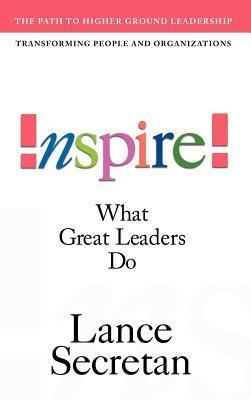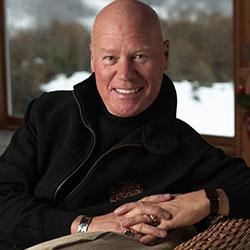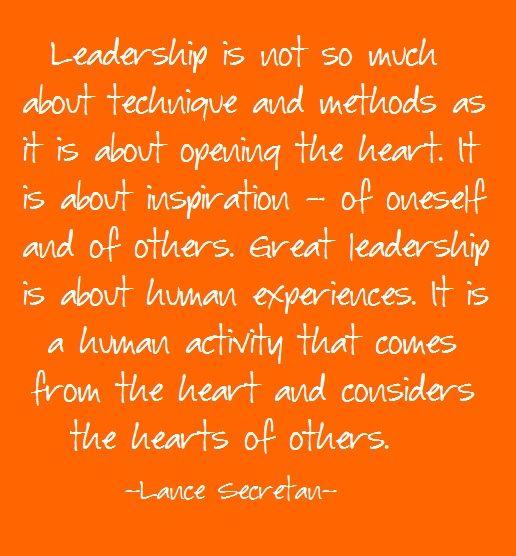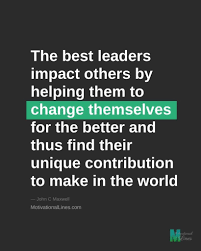By Manuel “Bobby” Orig, Director, Apo Agua

INSPIRE! What Great Leaders Do by Lance Secretan
We all yearn to be inspired. Yet today, many people are drifting in organizations, teams, and families that operate from a place of fear. Within the hearts of people everywhere, there is a yearning for something different.
What do great leaders share? One attribute has been shared – they aimed not to motivate but to inspire. What are the unique qualities found in these leaders? And how can you apply their style of leadership.
Inspire! is a book about how to inspire others and ourselves, the requisite for personal and organizational transformation. Based on lifetime of research, Lance Secretan takes us on a compelling journey to discover what all great, inspiring leaders have known: their Destiny (Why I am here on Earth), their Cause ( How I will be while I am here and what I will stand for), and their Calling (What I will do and how I will use my talents and gifts to serve).
Inspire! introduces a breakthrough leadership practice that leaps past conventional theory by defining a deeper, more enriching kind of leadership.
By engaging people on a new level – by honoring, exciting, and nourishing their souls – we can give them more than a reason to work; we can give them a passion for work.
Praise for the Book
Lance Secretan believes everyone is blessed with good qualities that make each of us special. He provides a road map to help you discover who you are, what your purpose is, and how to realize your potential, while, at the same time, energizing and empowering others to do the same.
—LILLIAN VERNON, founder, Lillian Vernon Corporation.
About the Author

LANCE SECRETAN is one of the world’s foremost thinkers and researchers on effective leadership. His breakthrough ideas about how to become inspired and how to inspire others have led to the transformation of individuals, teams, communities, and organizations. An author and award-winning columnist, corporate mentor, advisor to corporations and governments, and one of America’s sought after keynote speakers, he frequently addresses audiences around the world. The former architect of Manpower Limited, he has been ambassador to the United Nations Environment Program and Chairman of the Advisory Board of the 1997 Special Olympics World Winter Games.
INTRODUCTION
One of the greatest needs of the human spirit is to be inspired and to inspire. Inspiration is the oxygen of the soul. Inspirations comes from love, not fear – we cannot be inspired if we are not loving and loved. Yet, it is a paradox of our times that we are more afraid and less inspired than ever before.
There has been a fundamental shift in how we view life – people filtering their experiences through new lenses of fear.
This growing level of fear that has characterized our lives in recent years has led to an epidemic loss of personal inspiration and widespread sense of personal sadness. Fear has seeped into the lives of all of us. We are afraid of health risks, personal safety, inadequate financial security on retirement, job loss, institutions, dying, isolation – and the list of fears is endless. Being inspired and optimistic is one thing; trying to inspire or be inspired from a place of fear is another thing altogether.
People are motivated by fear, but they are not inspired by it. Everythign that inspires us comes from love.
—Lance Secretan
WHO IS REQUIRED TO INSPIRE
We all need to be inspired and to inspire others. We are called to inspire in every aspect and stage of our lives – it is an essential ingredient of every part of the human experience. Inspiration builds relationships, forms friendships, changes thinking and philosophies, gives birth to new ideas, and shapes lives and hearts.
The author’s definition of leadership is anchored on this statement:
Leadership is a serving relationship with others that inspires their growth and makes the world a better place.
So often, leadership is rehearsed. We read books by former corporate leaders. We learn “techniques” and “the tricks of the trade”: how to dress, how to make a speech, how to command attention. Through all this, the soul waits patiently while the personality nudges itself. This is why leadership often gets such a bad press: It is practiced as a function instead of the result of noble, powerful, and passionately held values.

The truth is nothing happens without the presence of inspiring leadership. But the soul waits patiently, it often remains unheard – suspended. Meanwhile, the personality becomes aware of the soul and chooses – or is sometimes forced – to listen to it. This is when we change from “acting” to “being” – perhaps the most important change in our lives.
This is the difference between old story leadership and New Story Leadership – the difference between working from the personality alone on the one hand, and aligning the personality and the soul on the other – the difference between doing and being, the difference between being unconscious and becoming conscious. It is the difference between talking about Higher Ground Leadership and being a Higher Ground Leader.
“HOW CAN I BE KIND, INSTEAD OF RIGHT?”
Often being a Higher Ground Leader can be made easier by asking ourselves the question, “Who am I serving right now, my ego or the soul of another being?” When our relationships or our communications become tangled or toxic, it is often because we are serving ourselves and our ego’s need to be right. Next time you are engaged in a heated discussion with a supplier, customer, or colleague – or your spouse or children – pause for a moment and ask yourself the quintessential question of the Higher Ground Leader: “How can I be kind, instead of right?”

Being right serves the ego; being kind serves the soul. Being right serves me; being kind serves us. Being kind inevitably leads to the question, “How may I serve you?”
Serving others and practicing business kindness is not the first business model that springs to mind when we think about corporate executives or leaders of organizations. This may be because we unconsciously train aggression into contemporary leaders.
When Cornell University asked 250 business school students what traits they thought made a great leader, they put “being result’s-oriented” at the top of their list and 60 percent said they admired Jack Welch, former CEO of General Electric Co., and ranked him as the most admired and respected executive in America. At the same time, he was also notorious among those who knew him for his toughness and profanity. Fortune Magazine reported that Jack Welch “conducts meetings so aggressively that people tremble. He attacks almost physically with his intellect – criticizing, demeaning, ridiculing, humiliating.”
When we pay tribute and celebrate the characteristics of violence and intimidation, holding them up to be the qualities of exemplary leaders, what message are we sending current and future leaders? What kind of leader are we encouraging them to follow? In the case of many old story led organizations, the numerous labor disputes, financial woes, and corporate scandals they have endured suggest that old story leadership inevitably contributes to the paradox of our times -profits are up, but people are down.
FROM OUT THERE TO IN HERE

A leader who does not inspire is like a river without water. Every follower yearns to be inspired by his or her leader. Indeed, every person yearns to be inspired by every other person. When we fail to do so, we diminish each other and sadden our souls. Thus the role of each of us is to inspire.
So the author set out a journey of discovery the answers to these questions:
- Why are we short of great contemporary examples of people who inspire us?
- Why are we unable to discern and practice a durable theory of inspiration?
As the author began to research the great inspirers throughout history, learning about their characteristics and searching for clues about their unique gifts, he found a common theme. The most inspiring people in history had a clear inner knowing about their:
- Destiny (Why am I here on Earth).
- Cause (How will I be while I am here – what will I stand for).
- Calling (What will I do and how will I use my talents and gifts to serve).
The author call this combination the “Why-Be-Do.”
The most inspiring leaders in history knew these things. From 10 years of research, the author distilled a series of sacred insights that evolved into a model, based on the wisdom of these great people. The essence of their greatness as inspirers and leaders was about being as well as doing – how they lived inspiring lives and therefore inspired others and themselves.
These insights inspired the author to form a body of work that he call Higher Ground Leadership that has since been taught to thousands of people around the world by hundreds of teachers. It forms the heart of this book.
When we peel away the outer theories and the models postulated by so many writers, theorists, and students of leadership – one thing remains at the essence of the practice of great leadership – inspiration. What do great leaders do? They inspire. What does a parent do to encourage brilliance, growth, and values in their children? We could say that they lead them – but if we look closer, what they are really doing is inspiring them.
In the author’s search for something more profound than the usual personality-based ideas about inspiration and leadership, he found that all of these great people:
- Had extraordinary clarity about their Destiny, Cause, and Calling;
- Aligned these fully in their lives;
- Knew how to serve and bring out the best in others; and
- Had a gift for being inspired themselves.
CONFUSING MOTIVATION WITH INSPIRATION
Motivation which is based on fear, comes from the personality. Inspiration, which is based on love, comes from the soul.
How can we define soul? Most theories about leadership revolve around the ego and the personality. The secret of leaders who inspire is that they have grown so that they can comfortably integrate both personality and the ego.
What if we could inspire others by appealing to something within them that is far greater than the personality or the ego? What if we could excite something emotional or intuitive that is at the very essence of our humanness? What would we call this if we could find it, work with it, and engage it? The author think we would call this ineffable thing the soul – the holiness and sacredness within us that is larger than anything we can imagine in the narrow definition of personality or ego.
Motivation is momentary, Inspiration can last a lifetime. Motivation comes from outside, Inspiration comes from inside. Motivation pushes you, Inspiration pulls you.
—Dean Bokhari
While our personalities may be excited, stimulated, motivated, or intimidated – this can never be enough. We all need and want more and that more is found in a very deep place. Most of us never connect at that level. But what if we could? What if our leadership talents and understanding were such that every relationship honored this special place – the soul – and engaged it, excited it, honored it, and nourished it?
The source of motivation can be found in the personality; the source of inspiration is to be found in the soul.
Inspired leaders become enthused. The word enthuse derives from the Greek root words en and theos, meaning to be inspired and being possessed by the divine. So enthusiasm means “one with the energy of God.”
Thus, inspiration and enthusiasm are conditions desired by all of us. Individuals and teams who are inspired and enthused are operating on a different plane and they know it and cherish it. People frequently move from well-paying positions where they are highly motivated to lesser-paying positions where they are inspired. The new reality is that people want to work in inspiring organizations, for inspiring leaders, in inspiring industries and careers, doing work that inspires customers and suppliers and each other. Anything less than this is just a job.
We tend to assume that our role is to motivate others to achieve something. Yet the greatest leaders in history seldom thought this way – none of these leaders principally focused on getting other people to “do things.”
Motivation is something we “do” to someone; inspiration is something that is the result of a soulful relationship. Anyone who had the privilege of working with a mentor in their lives knows and appreciates the difference. The mentor is not in it for themselves; they are offering a gift to you, an act of love and service. Their generosity of spirit and their gift of learning is what inspires – them and you.
Motivation comes from a place of self-concern – “I want to change your behavior with a reward or incentive, so that, if you meet the targets or goals I set for you, I will meet my own needs and goals.”
Inspiration, on the other hand, comes from a place of love and service, with no strings attached – “I love you and wish to serve and teach you and help you to grow.” When we motivate, we serve ourselves first; when we inspire, we serve others first.
GUIDING THE CONTRIBUTION OF BRILLIANCE
Thirty years ago, Frederick Herzberg was one of the most popular business writers and organizational theorist of his day. Herzberg developed a keen interest in corporate life and studied the reasons why so many people were unhappy at work, and the reasons why so few others were happy.
One of Herzberg’s most important contributions was what he called “Motivation-Hygiene Theory,” in which he postulated the notion that people are motivated by certain factors (which he called “Motivational Factors”), while the absence of other factors resulted in employee demotivation.
Flying directly in the face of the prevailing wisdom of the time, he reasoned that salary, status, and security did not motivate people, and thus these factors were not motivators, but their absence nearly always proved demotivational, leading to poor mental hygiene. Thus, he called these “hygiene factors,” and among them he included company policies and administration, supervision, working conditions and interpersonal relations with colleagues and leaders. None of these, Herzberg argued, could be used effectively to motivate people, but their absence or inappropriateness was nearly always demotivational for employees.
On the other hand, Herzberg reasoned, employees tend to be motivated when presented with opportunities for achievement, when they are recognized for their accomplishments, when they are interested in and engaged by their work, when they feel stretched as a result of extra responsibilities or enlarged tasks, when they are encouraged to grow and accept higher levels of responsibility. Thus, he called these “motivational factors.”
Herzberg argued that the role of the leader was to keep both of these balls – hygiene factors and motivation factors – in the air at all times.
Today, we have a greater need than motivation – we want to be inspired. We are not looking to leaders to motivate us so much as we want them to lift our spirits. The real issue has become inspiration. The question for all of us today has become, “Am I doing everything I can to inspire every person with whom I interact – all the time.
INSPIRING PEOPLE TO GREATNESS
We have long been urged to “concentrate on core competencies.” From Tom Peters and Bob Waterman, authors of In Search of Excellence, told us that the successful organizations in search of excellence “stick to their knitting,” focusing on what they do best and outsourcing functions where they are weak. A succession of management gurus has put their own spin onto this notion, but it all comes down to a simple general theory of core competencies: If we focus on what we do best, we will get better at it, which leads to mastery.
The corollary is that organizations should stop doing those things where there is a perceived weakness. The intent is to encourage corporate strategists to guide their organizations to higher performance, and corporate leaders have paid attention. The result has been a boom in the practice of subcontracting, outsourcing, and forging strategic alliances with others whose strengths complement the weaknesses of their outsourcing partners.
But there is a paradox at work here. If it works so well with organizations, and if we buy the core competencies idea so completely, why don’t we apply the same principle to people? Guiding followers to brilliance depends on our playing to their strengths, not their weaknesses.
… BY WORKING ON THEIR STRENGTHS, NOT THEIR WEAKENESSES
When the author was president of Manpower Limited, he had a franchisee called John Harold. To this day, he has not met his equal as a marketer. Harold was absolutely brilliant. But if Harold was the Leonardo da Vinci of sales and marketing, he was the super-clumsy of administration – he couldn’t submit a form to save his life, let alone complete it accurately.
The author was the CEO, and was supposed to be the teacher and coach, but he began to realize it was John Harold who was giving the lessons. Finally, Harold reached him. He went down to Harold’s office one day and said, “John, whenever I visit you, I always compliment you on your brilliant sales performance and then I complain about your sales summaries. I am here to promise you that the last time I did this was the last time I will ever do so. I have hired someone on my payroll to complete your monthly summaries. Now how can I help you with your sales? How can I serve you?”
Whatever give the author the idea that he could turn one of the finest marketers into – at best – a mediocre form-filler? And why would he want to? Why was he so arrogant? Here was a certified one-of-a kind genius, and the author was about to squander his gifts and extinguish the flames of his inspiration.
We cannot guide the brilliance of others by getting everyone to do something the same way; we guide the brilliance from others by playing to their strengths, teasing greatness from them by honoring their gifts, and making it as easy as possible to be brilliant at what they do.
HIGHER GROUND LEADER
CASTLE is an acronym that describes the very obvious concepts that distinguish the Higher Ground Leader from the old story leader and which, when fully lived are profoundly inspiring to others. These are concepts that are within us already, but yearn to be recalled. It is through the CASTLE principles that we guide the contribution of brilliance from followers.
The Higher Ground Leader is guided in life and work by these six principles:
- Courage: Nothing happens until we become brave enough to reach inside our existing paradigms. When we are gripped by fear, we become ineffective and our performance is diminished – at work and at home;
- A commitment to Authenticity: showing up and being present in all aspects of life, removing the mask and becoming a real, vulnerable, and intimate human being, a person who is genuine and emotionally and spiritually connected to others;
- A desire to Serve: departing from an old story, self-focused, fear-based mode, and instead focusing on the needs of others by listening to them, identifying their needs and meeting them – and thus inspiring them.
- A passion for and commitment to the Truth: The refusal to compromise integrity or to deny universal truths – even though in these testing times, avoiding the truth might, in the face of it, seem easier.
- The capacity to Love: the source of a Higher Ground Leader’s ability to inspire others, and the spiritual and psychological antidote to fear, stress, and anger, which, when freely given, results in people who are;
- Effective in all aspects of life.
COURAGE
Without courage we cannot take the first steps because they contain so much perceived risk. We are afraid of how we will be judged and that our personalities might be diminished by the criticism of others. The soul understands the need and the desire to take the appropriate action to change culture and actions at home and work, but the ego stands in the way.
Courage is the fire that energizes the clarity, choice, and commitment. Until we listen to our inner voices, to our souls, inviting our ego to take a secondary role, courage will not be present, but when we do, courage will emerge and give us the one thing that we lack – will. It is the will to make change that starts the process; it is the will that invests fire into our passion, fanning the flames in our souls, so that we can become instruments of change.
Courage gives us the will to do what is necessary to make change, to rise above the intimidation that our personalities experience from the personalities of others. Without courage, we are unlikely to discover our Destiny, Cause, and Calling, let alone live them.
AUTHENTICITY
It is not until we become courageous that we can become authentic. It takes courage to be real, because to be real requires us to be brave enough to reveal, to own – and sometimes share our truth, our fears, our emotions, and our vulnerabilities.
Most of us know inauthentic people – people who say one thing and do another; people who feel one thing but say another; people who think one thing but do another. Authenticity is the opposite of this. When we are authentic, we align our minds, our mouths, our hearts, and our feet with complete congruence. This is how we become real.
Authenticity, as much as anything, generates love in the hearts of others because our souls are crying out for authenticity. What followers yearn for are leaders who are authentic, and therefore trusted.
NOT EVERYTHING CAN BE MEASURED
Inspiration is often unmeasurable. This is very perplexing and frustrating for analysts so anxious to reduce the concept of inspiration to a finite science. But some things cannot be quantified. Higher Ground Leaders emanates from an inspired place. Sometimes our inquiring scientific minds are not up to the task of analysis, and in those situations, it is best if we simply trust in the ineffable.

Performance metrics and measures are ever present fact of life. The old adage, “What gets done gets measured” stands guard over our lives at work and at home. Prevailing wisdom for many people is that what we do not analyze and measure with some form of quantitative calipers, is not real or experienced.
Meg Whitman who powered eBay to a billion dollar Internet juggernaut with over 60 millions users says, “If you can’t measure it, you can’t control it. Being metrics-driven is an important part of scaling to a very large company. In the early days you could feel it, you could touch it. Now that’s more difficult, so it has to be measured.” Measurement is a vital part of work life and a necessary part of success – eBay is testimony to this mastery.
But life is in two parts – that which can be measured, and that which cannot.
There are other ways to measure the realities and experiences of life, and other ways to achieve our dreams. There are many aspects of our life that will simply not yield to conventional metrics. How do you measure the way a glorious sunset touches your soul? What stirs inside you when you hear beautiful music or poetry? What criteria would you use to measure the visceral experience of holding a newborn baby? How do you measure the magic of a full moon, or the beauty of the Mona Lisa? How does one plot a chart or create a graph of being deeply in love? Is there a 10-point scale for measuring a profound sense of gratitude? These are moments that touch your soul and are as real perhaps even more so, than many other so-called measurable experiences in life.
THE PATH TO INSPIRATION
There is a natural Law of Inspiration – “To be inspired by others, you must first inspire.’ We intimately understand this logic, if we inspire others, they will inspire us.
The purpose of the healthy, soul-guided ego is to serve others, and when ego does this effectively, it does something even bigger – it serves the soul. This is “The Path to Inspiration,” because when we do this, we are always an inspiration to others and ourselves. But when our ego seek to serve ourselves more than others, we descend into egocentricity, and it is here that we spend so much time in our shadow. When we behave this way, we display hubris and arrogance that comes from the self-serving, unhealthy ego.
But if, on the other hand, we abandon or suppress our ego, failing to take sufficient care of our own needs as we sacrifice them on behalf of others, we become ascetic (the practice of denying ourselves) and therefore we can be of little value to others. This is when service is stretched into sacrifice – the Path of Asceticism.
It is ironic that so many people feel that, although they have dedicated themselves so fully, to their families and work – they feel they “don’t get no respect.” Often, this perception is real and caused by their persistently manipulative behavior masquerading as a desire to serve others, but in reality, is a means to serve themselves. They can’t seem to do anything for someone else without attaching strings or harboring some ulterior motive. This is the Path of Ego that is serving self.
To inspire others you must first inspire yourself. Only true passion can awake passion in others.
—Daniel Delgado
A question we keep in our hearts is this: Who is leading – the ego or the soul? If the ego is out front, the priority becomes oneself – self-absorption, and this can lead to selfishness, arrogance, aggression, and the need to dominate and control. This is the behavior that others find uninspiring. If the soul is an equal, or even principal, guide in our lives, the priority changes to serving others, this causes us to become people who serve and inspire.
IN SUMMARY
Inspiring others is an act of service that flows from love. Motivational leaders also love others, of course, but others are not their primary focus. Higher Ground Leaders make a loving connection with others. We all can see and feel the difference in a heartbeat. We sense the presence of a motivator – their manipulative and self-focused agendas are often so transparent. So too is the commitment to ego and personality, to the superficial and to the material.

Higher Ground Leaders love others so genuinely, they cannot resist serving them – and followers are at once inspired by this congruence. The result is a connection of souls, of people doing soulwork, and the creation of a sanctuary. These are magical moments and magical places in which to live and work because Higher Ground Leaders are fully present. In these exhilarating states, we become inspired. And to the great joy of those around us, we are inspired to offer our greatest gifts.
The Higher Ground Leader matures to this place, relying less on the technology of relationships and more on the natural grace of soul-to-soul connections. And thus begins the transition from the old story to New Story Leadership. This is the person who becomes so inspiring to others, that they become inspired by their capacity to inspire. This is the magic ingredient X of the Higher Ground Leader.
/// end

